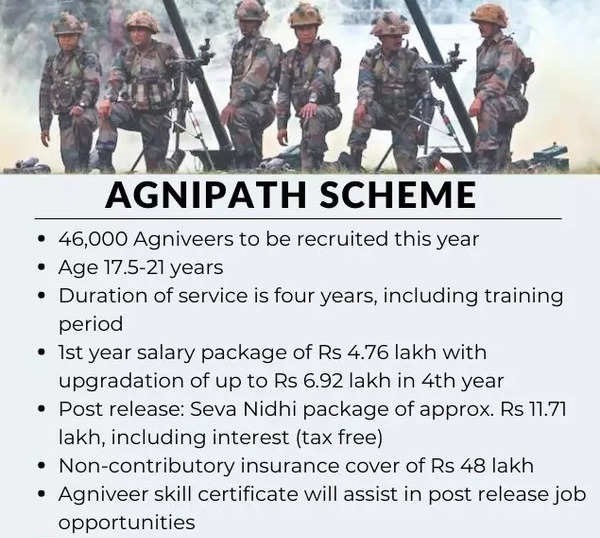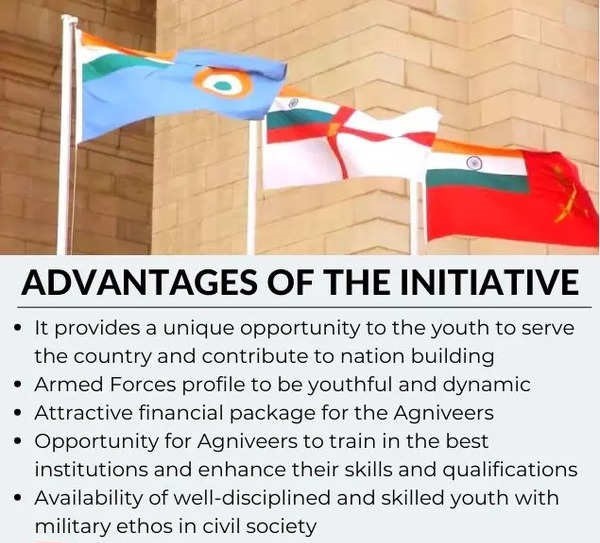Description

Disclaimer: Copyright infringement not intended.
Context
- In the first passing-out parade of Agniveers, 2,585 men and women graduated from the portals of Indian Naval Ship (INS) Chilka.
Agnipath Scheme
About
- The government unveiled its new Agnipath scheme for recruiting soldiers across the three services.
- The soldiers recruited under the scheme will be called Agniveers.
- Under the new scheme, around 45,000 to 50,000 soldiers will be recruited annually, and most will leave the service in just four years.
- Of the total annual recruits, only 25 per cent will be allowed to continue for another 15 years under permanent commission.

What is the eligibility criteria?
- The new system is only for personnel below officer ranks (those who do not join the forces as commissioned officers).
- Aspirants between the ages of 17.5 years and 21 years will be eligible to apply.
What happens after selection?
- Once selected, the aspirants will go through training for six months and then will be deployed for three and a half years.
- During this period, they will get a starting salary of Rs 30,000, along with additional benefits which will go up to Rs 40,000 by the end of the four-year service.
- Importantly, during this period, 30 per cent of their salary will be set aside under a Seva Nidhi programme, and the government will contribute an equal amount every month, and it will also accrue interest.
- At the end of the four-year period, each soldier will get Rs 11.71 lakh as a lump sum amount, which will be tax-free.
- They will also get a Rs 48 lakh life insurance cover for the four years.
- In case of death, the payout will be over Rs 1 crore, including pay for the unserved tenure.
- For those who are re-selected, the initial four-year period will not be considered for retirement benefits.
.jpeg)
For Women
- While the Indian Army will pick up the male recruits, the women will get to be recruited as Agniveers in the Indian Navy and Indian Air Force.
How will they be assessed?
- A robust assessment system will be used to track the performance of the Agniveers.
- Ministry of Skill and Development and Entrepreneurship will issue a certificate highlighting the proficiency of the Agniveer in a skill-set.
The Numbers
- The defence budget of Rs 5,25,166 crore for 2022-23 included Rs 1,19,696 crore for defence pensions.
- The allocation for revenue expenditure was Rs 2,33,000 crore.
- The revenue expenditure includes the expenses on payment of salaries and maintenance of establishments.
- India has the second largest active armed forces in the world with some 1.45 million active duty personnel.
- Along with reserves and paramilitary forces, India has over 5 million military personnel -- above China and Russia -- and is the 4th largest military in terms of total personnel.
- However, it ranks 9th in terms of total military personnel per 1,000 capita; and 10th in active duty personnel per 1,000 capita.
- It also has the third largest military budget in the world after US ($801 billion) and China ($292 billion).
- However, India spends a large portion of this budget on paying pensions, salaries and maintenance.
- In terms of military expense as a percentage of GDP, India ranks sixth in the world.
- According to a report by Global Firepower (GFP), which tracks military capability and defence networks, India has the fourth most powerful military in the world.
Benefits
- The move will make the permanent force levels much leaner for the over 13-lakh strong armed forces in the country. This will, in turn, considerably reduce the defence pension bill, which has been a major concern for governments for many years.
- Recruitment under the scheme which will bring “all India, all class” recruitment to the services. This is especially significant for the Army, where the regiment system has region and caste bases, and with time that will be eliminated to allow anybody from any caste, region, class or religious background to become part of existing regiments.
- The average age in the forces is 32 years today, which will go down to 26 in six to seven years, the scheme envisions.
- It will create “future-ready” soldiers.
- Efforts are being made that the profile of the Armed Forces should be as youthful as the wider Indian population. A youthful armed forces will allow them to be easily trained for new technologies.
- It will increase employment opportunities and because of the skills and experience acquired during the four-year service such soldiers will get employment in various fields.
- The government will help rehabilitate soldiers who leave the services after four years. They will be provided with skill certificates and bridge courses. The impetus will be to create entrepreneurs, he added.
- Those who will complete their four years as soldiers, airmen and sailors will also get preference in Assam Rifles and Paramilitary Forces.

Agnipath Concerns
- The military profession is not just another job but a calling where individuals stand ready to sacrifice all in service to the nation. There should be no shift away from this calling towards viewing the military as just an occupation.
- The question is whether unit cohesion would be diluted when there are two classes of soldiers with different service conditions. Would the competition among the Agniveers for the 25 percent permanent posts strengthen or weaken unit cohesion?
- How would the shortening of the training period affect operational effectiveness?
- As more and more Agniveers get recruited into the military, ultimately reaching 50 percent in the next ten years, what kind of responsibilities can these inexperienced soldiers be assigned?
- All future recruitment will be on an All India All Class basis. How would this impact the Indian Infantry's regimental system that has stood the test of time?

Way Forward
- The first four years of the Agnipath scheme should be treated purely as a validation period. The primary purpose of the validation should be to assess the scheme's impact on the operational efficiency of the military. All other repercussions are secondary.
- After conducting a comprehensive review, the military leadership should present their findings to the government. The conclusions should focus on assessing the Agnipath scheme's impact on the military's operational effectiveness. If required, the government should be open to changes, including significant modifications to the scheme.
- The government and the private sector must step up to do whatever is possible to ensure that the Agniveers can transition to a second career.
Concluding Remarks
- Currently, there are two divergent viewpoints about the Agnipath scheme.
-
- One describes it as "the single biggest human resources management transformation in the Indian military." With its implementation, the military will become a “future-ready fighting force, capable of meeting multiple challenges across the full spectrum of conflict.”
- The second viewpoint urges caution and voices concern over the long-term impact of the scheme on training standards, unit cohesion, and operational effectiveness.
- It is, therefore, recommended that the first four years of the Agnipath scheme be treated as a testbed from which valuable lessons can be learned.
|
PRACTICE QUESTION
Q) With national security at stake, a radical change of the kind envisaged by the Agnipath scheme must be put through a rigorous test, and as found necessary adapted, before final implementation. Critically Analyse this statement. (250 words)
|

https://epaper.thehindu.com/ccidist-ws/th/th_delhi/issues/30434/OPS/GHSB1VCD0.1+GHGB206GB.1.html


















